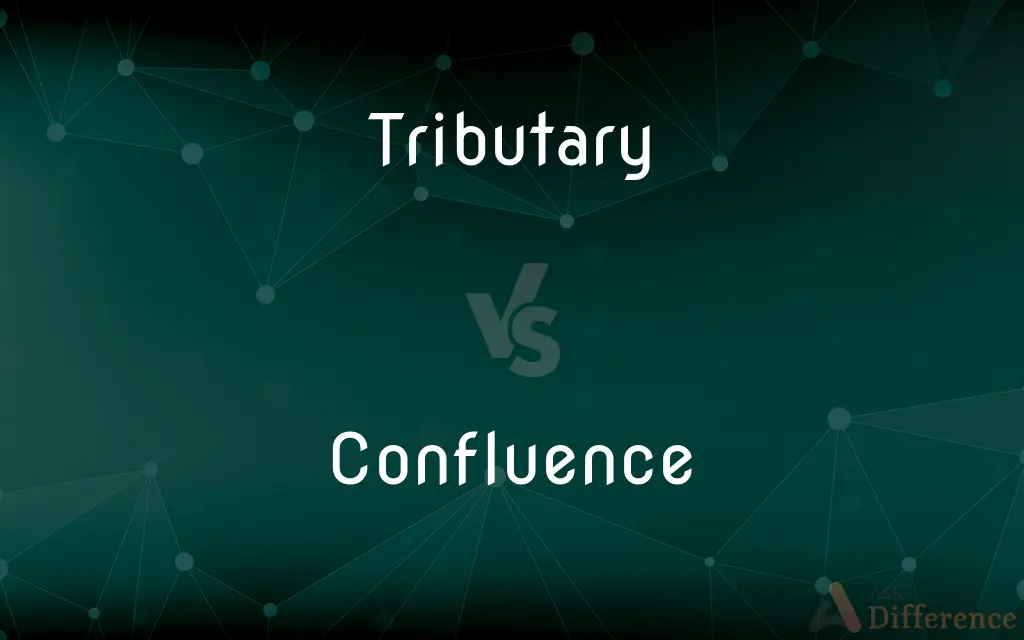Tributary vs. Confluence — What's the Difference?
By Tayyaba Rehman & Urooj Arif — Updated on March 21, 2024
A tributary is a stream or river that flows into a larger river, while a confluence is the point where two or more bodies of water meet and combine.

Difference Between Tributary and Confluence
Table of Contents
ADVERTISEMENT
Key Differences
A tributary serves as a supplementary water source, feeding into a larger river system and increasing its flow, whereas a confluence represents a junction where two or more rivers merge, forming a single watercourse.
Tributaries can significantly impact the volume, sediment load, and water quality of the main river, enriching its ecosystem. On the other hand, confluences are notable geographical features that often become strategic locations for settlements due to their importance in navigation, commerce, and cultural significance.
While tributaries contribute to the complexity and reach of a river network, enhancing its drainage capacity, confluences can alter the river's direction, dynamics, and sometimes its name.
The role of tributaries in ecosystems is crucial for biodiversity, providing habitats for various species, while confluences can create unique ecological niches and opportunities for species interaction and diversity.
Comparison Chart
Definition
A smaller river or stream that flows into a larger one.
The meeting point of two or more bodies of water.
ADVERTISEMENT
Function
Increases the water volume and carries sediment to the main river.
Marks the point where water bodies merge and flow as one.
Impact on Ecosystem
Provides diverse habitats and supports biodiversity.
Creates unique ecological zones with varied biodiversity.
Significance in Geography
Highlights the river's drainage network and capacity.
Indicates strategic locations for human settlement and navigation.
Cultural and Historical Importance
Less prominent compared to confluences.
Often significant, marking borders, cities, or historical sites.
Compare with Definitions
Tributary
A smaller river or stream that flows into a larger one, increasing its water volume.
The Missouri River is a major tributary of the Mississippi River.
Confluence
Can result in a river changing its course.
At the confluence, the combined river may take a new direction.
Tributary
Can originate from springs, lakes, or other rivers.
The Logan River, originating in the mountains, is a tributary to the Bear River.
Confluence
A site for biodiversity and unique ecosystems.
The Amazon’s confluences create habitats for diverse species.
Tributary
Plays a role in the river's drainage system.
The Ganges is supported by many tributaries, enhancing its drainage capacity.
Confluence
The point where two rivers meet and continue as one.
The confluence of the Rhine and Moselle Rivers is a key European navigational point.
Tributary
Contributes to the main river’s flow and biodiversity.
Numerous small tributaries feed into the Nile, supporting its vast ecosystem.
Confluence
Strategic location for human settlements.
Ancient civilizations thrived at the confluences of major rivers.
Tributary
Influences the sediment and nutrient content of the river.
Sediment from the tributaries helps to fertilize the Nile Delta.
Confluence
Often marks important cultural or geographical boundaries.
The confluence of the Ohio and Mississippi rivers has historical significance.
Tributary
A tributary or affluent is a stream or river that flows into a larger stream or main stem (or parent) river or a lake. A tributary does not flow directly into a sea or ocean.
Confluence
In geography, a confluence (also: conflux) occurs where two or more flowing bodies of water join together to form a single channel. A confluence can occur in several configurations: at the point where a tributary joins a larger river (main stem); or where two streams meet to become the source of a river of a new name (such as the confluence of the Monongahela and Allegheny rivers at Pittsburgh, forming the Ohio); or where two separated channels of a river (forming a river island) rejoin at the downstream end.
Tributary
A stream that flows into a larger stream or other body of water.
Confluence
A flowing together of two or more rivers or streams.
Tributary
A ruler or nation that pays tribute.
Confluence
The point of juncture of such rivers or streams.
Tributary
Making additions or yielding supplies; contributory.
Confluence
The combined river or stream formed by this juncture.
Tributary
Paid in tribute.
Confluence
A gathering, flowing, or meeting together at one juncture or point
"A confluence of negative events conspired to bring down bond prices" (Michael Gonzalez).
Tributary
Paying tribute
A tributary colony.
Confluence
The act of combining that occurs where two rivers meet.
The confluence of the rivers produced a great rush of water.
Tributary
(hydrology) A natural water stream that flows into a larger river or other body of water.
Confluence
The place where two rivers, streams, or other continuously flowing bodies of water meet and become one, especially where a tributary joins a river.
We encountered an abandoned boat at the confluence of the Mississippi and Ohio Rivers.
Tributary
(anatomy) A vein which drains into a another vein.
The great saphenous vein is a tributary of the femoral vein.
Confluence
The stream or body formed by the junction of two or more streams; a combined flood.
Tributary
A nation, state, or other entity that pays tribute.
Confluence
A convergence or combination of forces, people, or things.
The confluence of our skills resulted in a successful home renovation project.
The political turmoil was the result of a confluence of factors, and the corollary of years of misrule, as evidenced by a low home ownership rate incommensurate with the economic growth.
Confluence of sinuses
Tributary
Related to the paying of tribute.
Confluence
(biology) The proportion of cells, in a culture medium, that adhere to each other.
Tributary
Subordinate; inferior
Confluence
A property describing which terms can be rewritten with other, equivalent terms.
Tributary
Yielding supplies of any kind; serving to form or make up, a greater object of the same kind, as a part, branch, etc.; contributing.
The Ohio has many tributary streams, and is itself tributary to the Mississippi.
Confluence
The act of flowing together; the meeting or junction of two or more streams; the place of meeting.
New York stood at the confluence of two rivers.
Tributary
Paying tribute to another, either from compulsion, as an acknowledgment of submission, or to secure protection, or for the purpose of purchasing peace.
[Julius] unto Rome made them tributary.
Confluence
Any running together of separate streams or currents; the act of meeting and crowding in a place; hence, a crowd; a concourse; an assemblage.
You see this confluence, this great flood of vistors.
The confluence . . . of all true joys.
Tributary
Hence, subject; subordinate; inferior.
He to grace his tributary gods.
Confluence
A place where things merge or flow together (especially rivers);
Pittsburgh is located at the confluence of the Allegheny and Monongahela rivers
Tributary
Paid in tribute.
Confluence
A flowing together
Tributary
Yielding supplies of any kind; serving to form or make up, a greater object of the same kind, as a part, branch, etc.; contributing; as, the Ohio has many tributary streams, and is itself tributary to the Mississippi.
Confluence
A coming together of people
Tributary
A ruler or state that pays tribute, or a stated sum, to a conquering power, for the purpose of securing peace and protection, or as an acknowledgment of submission, or for the purchase of security.
Tributary
A stream or river flowing into a larger river or into a lake; an affluent.
Tributary
A branch that flows into the main stream
Tributary
Of a stream; flowing into a larger stream
Tributary
Paying tribute;
A tributary colony
Tributary
Tending to bring about; being partly responsible for;
Working conditions are not conducive to productivity
The seaport was a contributing factor in the growth of the city
A contributory factor
Common Curiosities
Can a lake have tributaries?
Yes, lakes can have tributaries, which are streams or rivers that flow into them, increasing their water level.
Why are confluences important?
Confluences are strategic points for navigation, settlements, and often have significant cultural or historical value.
What is a confluence?
A confluence is where two or more bodies of water meet and flow together.
Do all rivers have tributaries?
Most rivers have tributaries, although the number and size can vary widely.
Are tributaries always smaller than the main river?
Yes, tributaries are generally smaller in volume and length compared to the river they feed into.
What is a tributary?
A tributary is a river or stream that flows into a larger river, contributing to its water volume.
How do tributaries influence river navigation?
Tributaries can enhance river navigation by increasing water depth and flow, supporting larger vessels.
Do confluences always occur in flat areas?
Not necessarily, confluences can occur in various topographies, including mountainous regions and plains.
Can human activities impact tributaries?
Yes, pollution, dam construction, and water diversion can significantly affect tributary health and ecosystems.
How does a tributary affect a river?
Tributaries increase a river’s flow, sediment load, and nutrient content, enriching its ecosystem.
Is the meeting of a river with the sea considered a confluence?
No, the meeting of a river with the sea is typically called a river mouth, not a confluence.
How do confluences affect river ecosystems?
Confluences can create unique ecological zones, promoting biodiversity and offering habitats for various species.
Can a river have more than one confluence?
Yes, a river can have multiple confluences as it meets and merges with other rivers along its course.
What role do confluences play in human history?
Confluences have been crucial for trade, settlement, and cultural development throughout human history.
Are there any famous confluences?
Yes, the confluence of the Blue Nile and White Nile in Khartoum, Sudan, is among the most famous worldwide.
Share Your Discovery

Previous Comparison
Noodle vs. Dumpling
Next Comparison
Machine vs. ToolAuthor Spotlight
Written by
Tayyaba RehmanTayyaba Rehman is a distinguished writer, currently serving as a primary contributor to askdifference.com. As a researcher in semantics and etymology, Tayyaba's passion for the complexity of languages and their distinctions has found a perfect home on the platform. Tayyaba delves into the intricacies of language, distinguishing between commonly confused words and phrases, thereby providing clarity for readers worldwide.
Co-written by
Urooj ArifUrooj is a skilled content writer at Ask Difference, known for her exceptional ability to simplify complex topics into engaging and informative content. With a passion for research and a flair for clear, concise writing, she consistently delivers articles that resonate with our diverse audience.















































